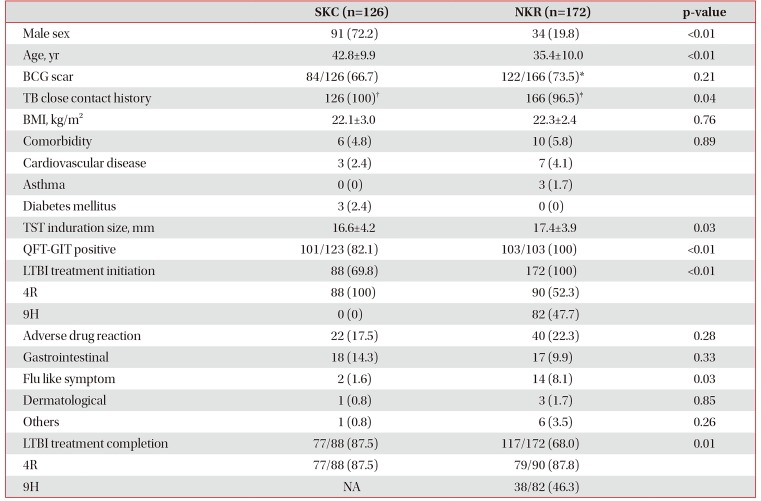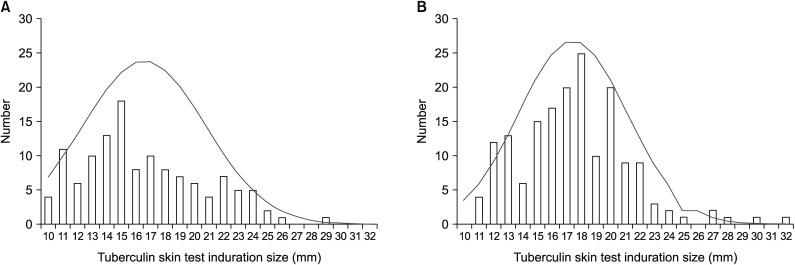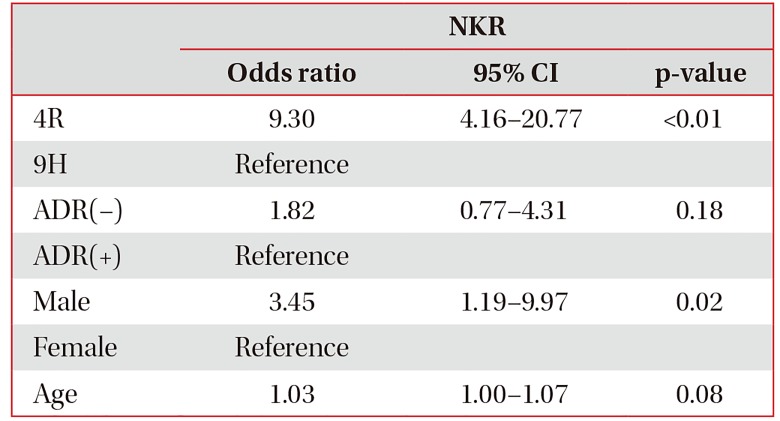3. Cho KS. Tuberculosis control in the Republic of Korea. Epidemiol Health. 2018; 40:e2018036. PMID:
30081621.

4. Min GH, Kim Y, Lee JS, Oh JY, Hur GY, Lee YS, et al. Social and clinical characteristics of immigrants with tuberculosis in South Korea. Yonsei Med J. 2017; 58:592–597. PMID:
28332365.

5. Lee S, Ryu JY, Kim DH. Pre-immigration screening for tuberculosis in South Korea: a comparison of smear- and culture-based protocols. Tuberc Respir Dis. 2019; 82:151–157.

6. Choi CM, June JH, Kang CI, Park JT, Oh SY, Lee JB, et al. Tuberculosis among dislocated North Koreans entering Republic of Korea since 1999. J Korean Med Sci. 2007; 22:963–967. PMID:
18162707.

7. Ann SY, Ryou SH, Kim SB. Clinical characteristics of defectors from North Korea visiting a single tertiary hospital in South Korea. Korean J Med. 2015; 89:54–63.

8. Farhat M, Greenaway C, Pai M, Menzies D. False-positive tuberculin skin tests: what is the absolute effect of BCG and non-tuberculous mycobacteria. Int J Tuberc Lung Dis. 2006; 10:1192–1204. PMID:
17131776.
9. Joint Committee for the Revision of Korean Guidelines for Tuberculosis. Korean Centers for Disease Control and Prevention. Korean guidelines for tuberculosis. 3rd ed. Cheonju: Korea Centers for Disease Control and Prevention;2017.
10. Fox GJ, Dobler CC, Marais BJ, Denholm JT. Preventive therapy for latent tuberculosis infection-the promise and the challenges. Int J Infect Dis. 2017; 56:68–76. PMID:
27872018.

11. Chen S, Zhang H, Pan Y, Long Q, Xiang L, Yao L, et al. Are free anti-tuberculosis drugs enough? An empirical study from three cities in China. Infect Dis Poverty. 2015; 4:47. PMID:
26510711.

12. Venkatesan P. Changing the treatment landscape for latent tuberculosis with rifampicin. Lancet Respir Med. 2018; 6:740. PMID:
30104169.

13. Menzies D, Adjobimey M, Ruslami R, Trajman A, Sow O, Kim H, et al. Four months of rifampin or nine months of isoniazid for latent tuberculosis in adults. N Engl J Med. 2018; 379:440–453. PMID:
30067931.

14. Lee SH, Lew WJ, Kim HJ, Lee HK, Lee YM, Cho CH, et al. Serial interferon-gamma release assays after rifampicin prophylaxis in a tuberculosis outbreak. Respir Med. 2010; 104:448–453. PMID:
19879123.

15. Lee SH, Yim JJ, Kim HJ, Shim TS, Seo HS, Cho YS, et al. Adverse events and development of tuberculosis after 4 months of rifampicin prophylaxis in a tuberculosis outbreak. Epidemiol Infect. 2012; 140:1028–1035. PMID:
21835069.

16. Diel R, Loddenkemper R, Meywald-Walter K, Gottschalk R, Nienhaus A. Comparative performance of tuberculin skin test, QuantiFERON-TB-Gold In Tube assay, and T-Spot.TB test in contact investigations for tuberculosis. Chest. 2009; 135:1010–1018. PMID:
19017873.
17. Seung KJ, Linton SW. The growing problem of multidrugresistant tuberculosis in North Korea. PLoS Med. 2013; 10:e1001486. PMID:
23935457.

18. Kim YN. Narrative Inquiry about entering process South Korea, NIS investigation course and Hanawon center curriculum of North Korean defectors. J Hum Rights Law Relat Educ. 2016; 9:33–64.
19. Park SJ, Jo KW, Yoo B, Lee CK, Kim YG, Yang SK, et al. Comparison of LTBI treatment regimens for patients receiving anti-tumour necrosis factor therapy. Int J Tuberc Lung Dis. 2015; 19:342–348. PMID:
25686145.

20. Assefa Y, Assefa Y, Woldeyohannes S, Hamada Y, Getahun H. 3-month daily rifampicin and isoniazid compared to 6- or 9-month isoniazid for treating latent tuberculosis infection in children and adolescents less than 15 years of age: an updated systematic review. Eur Respir J. 2018; 52:1800395. PMID:
29748305.

21. Park SM, Lee HW. Current status of healthcare and effective health aid strategies in North Korea. J Korean Med Assoc. 2013; 56:368–374.






 PDF
PDF ePub
ePub Citation
Citation Print
Print





 XML Download
XML Download